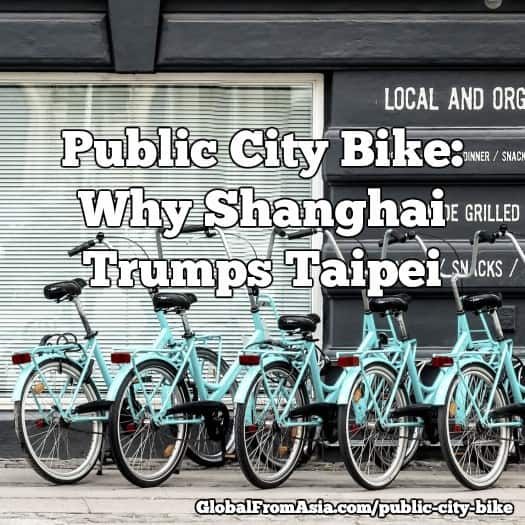
Shanghai just started to roll out public city bikes by a private company called Mobike. Taipei, on the other hand, has been offering public city bikes (uBike) by Giant since 2009. I have tried the city bike services in both cities, 2015 in Taipei and 2016 in Shanghai, and I believe that Shanghai’s city bike service is a lot more advanced compared to Taipei’s.
Park Station vs. Free Stand

Taipei’s city bikes require park stations. They have around 8,320 public bikes and 254 park stations in the city. This scale has allowed the bike service sufficient density with close proximity to riders. Taipei also has a mobile app which informs the rider where the closest park station is and whether there are available bikes at a particular station.
However, it is not totally problem-free. Sometimes, riders couldn’t find available parking slots in popular destinations. Some other times, riders couldn’t find available bikes in popular pick-up locations. The planning to match park station and bikes adds a huge complexity to the business model.
As a rider, I will always need to ensure the availability of the park stations at both pick up and destination points for my trip. Taipei needs to take into consideration their park station locations, the number of racks at each station, as well as bike numbers. It also requires city government cooperation for the installation of racks at the designated park stations.
On the contrary, Shanghai uses a free stand model. City bikes can be picked up and parked along their public streets. A mobile app notifies the riders where the closest bikes are and they can make a 15-minute reservation for pick up. The free stand model simplifies the demand-supply planning to bikes only. Picking up and returning the bikes becomes hassle-free. This is a huge convenience for riders and encourages high utilization of bikes. This model also allows rapid city expansion as there is no need for government approval to install park stations around the city. This business model is highly scalable!
Product Simplification is Critical

Compared to Taipei bikes, Shanghai bikes are simplified significantly. The seats are not adjustable and they only have a single gear. The bike tires are solid rubber and not inflatable. All these simplifications are aligned with their business strategy: to focus on providing short distance travel (not comfortable travel) with maximum product life and low maintenance costs.
The removal of park stations is another simplification for Shanghai bikes. Some features were transferred from park stations to bikes. The GPS and internet connectivity (for locking and unlocking) were added to the bikes individually. The cost per bike might be higher, but the total cost of ownership is significantly reduced.
Dynamic Pricing to Manage Supply and Demand?

This has not happened yet, but I predict that this will happen soon when Shanghai public bike numbers reach a meaningful critical mass.
To balance supply and demand, Taipei relies on public workers to transfer the bikes between stations using trucks. This is an inefficient way to manage the supply and demand of bikes.
I predict that Shanghai bikes will soon introduce dynamic pricing (and payment). Basing on historical data and real-time usage, the supply and demand prediction can be very accurate. Higher prices will be charged during rush hours at popular pickup locations. Lower prices will be charged at popular destinations to encourage usage. Heck, I would not be surprised to see riders get paid (subsidized) for riding a bike from rural areas to downtown!
It is an exciting period to see more green and well-designed projects in China these days!

This article was originally published on LinkedIn by Mr. Xing Gao.